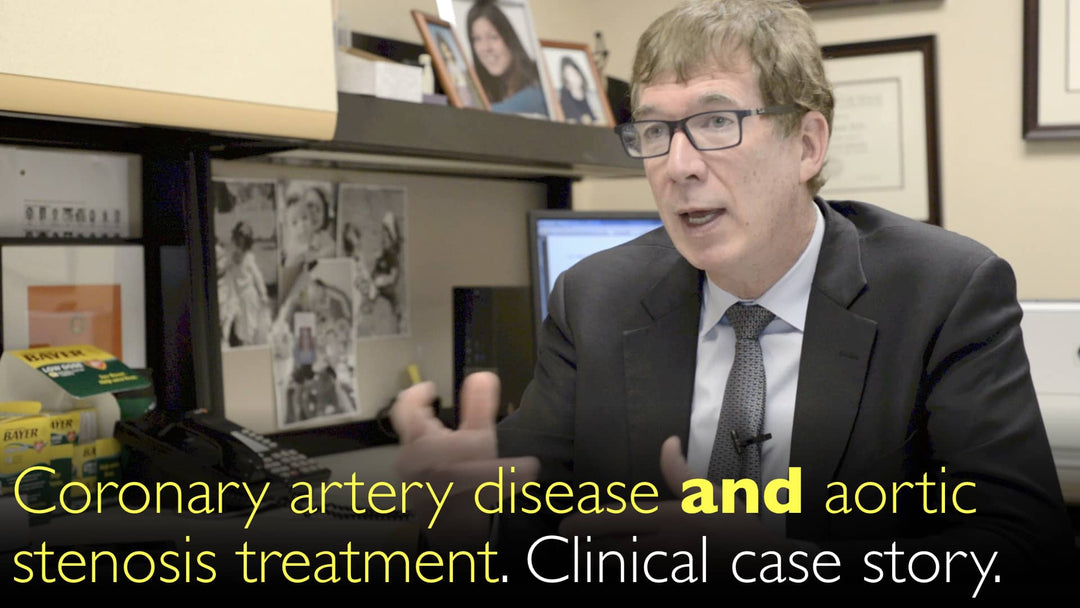インターベンション心臓病学の権威、Jeffrey Popma医師(医学博士)が、重度の大動脈弁狭窄症と冠動脈疾患を併せ持つ患者の治療戦略について解説します。85歳男性の複雑な症例を題材に、経カテーテル的大動脈弁置換術(TAVR)と冠動脈ステント留置の優先順位決定プロセスを詳述。大動脈弁置換が冠灌流を改善し狭心症を緩和するメカニズムを解説するとともに、現行ガイドラインの推奨事項についても考察します。
大動脈弁狭窄症と冠動脈疾患の併存に対する最適治療戦略
セクションへ移動
複合心疾患の治療課題
大動脈弁狭窄症と冠動脈疾患を併存する患者の治療は、臨床上の大きな課題となります。Jeffrey Popma医学博士は、これを現代循環器学においてエビデンスが最も乏しい領域の一つと位置づけています。中心的な問題は、両疾患に対処する最適な順序です。臨床医は、冠血行再建術を大動脈弁置換術の前、同時、あるいは後に行うかを判断しなければなりません。
この判断は患者の安全性と長期的な予後に大きく影響します。Jeffrey Popma医学博士は、Anton Titov医学博士との対談で、こうした症例の複雑さを強調しています。
臨床症例の提示
Jeffrey Popma医学博士は、複数の心血管疾患を抱える85歳男性の典型的な症例を紹介します。患者は重症の大動脈弁狭窄症と高度な冠動脈疾患を併存していました。冠動脈造影では、左前下行枝(LAD)の近位から中部にかけて90%の高度狭窄が認められました。
さらに右冠動脈と回旋枝にも50%の狭窄がありました。症状には典型的な胸痛と高度の呼吸困難が含まれていました。この症例は、高齢者における複合心疾患治療の意思決定の難しさをよく示しています。
大動脈弁置換術の利点
TAVI(経カテーテル的大動脈弁植入術)または外科的大動脈弁置換術は、著明な生理学的メリットをもたらします。Jeffrey Popma医学博士によれば、大動脈弁狭窄症の解除により冠血流が劇的に改善されます。これにより左心室拡張終期圧が良好に低下します。
また、心筋全体の酸素需要も減少します。これらの相乗効果により、追加の冠動脈介入を行わなくても狭心症症状が消失することが少なくありません。Jeffrey Popma医学博士は、この知見が大動脈弁狭窄症患者に対する冠動脈ステント治療の積極性を変化させたと指摘しています。
冠血行再建ガイドライン
現行のガイドラインでは、併存する冠動脈疾患の管理について特定の推奨が示されています。Jeffrey Popma医学博士は、Steve Ramee医学博士が執筆した米国心臓病学会の指針を引用しています。これらの推奨では、特定の冠動脈病変に対しては依然として血行再建術が適応となるとされています。
近位LAD病変や左主幹部病変は通常、治療介入が必要です。Popma博士によれば、血行再建には二つの主な目的があります。一つは大動脈弁処置の安全性を高めること、もう一つはTAVI施行後に生じうる冠動脈アクセス困難への事前対応です。
治療意思決定
治療順序の決定には、多角的な要因を慎重に検討する必要があります。提示された症例では、Jeffrey Popma医学博士らのチームはまず冠動脈疾患の治療を選択しました。重度に狭窄したLADに対し、長いSynergy冠動脈ステントを留置しました。
このアプローチにより、TAVI施行前に冠血流を安定させることができました。患者は1か月後の経カテーテル的大動脈弁置換術のために再来院予定となりました。Popma博士はAnton Titov医学博士に対し、こうした複雑な症例に対する最善のアプローチは未だ確立されていないと認めています。
この症例は、弁膜症と冠動脈疾患の併存管理が進化中の領域であることを浮き彫りにしています。
全文書き起こし
Anton Titov医学博士: 大動脈弁狭窄症と高度冠動脈疾患を併存する患者では、最良の治療オプションをどのように選択すべきでしょうか?まず大動脈弁を治療すべきか、それとも冠動脈ステント治療から始めるべきか?議論の余地がある臨床症例はありますか?
Jeffrey Popma医学博士: はい。何をすべきかについて不確実性が残る場合があります。日常的な心疾患治療の中で最も難しく、エビデンスが乏しい領域の一つがこれです。冠動脈疾患と大動脈弁狭窄症を併存する患者の血行再建問題です。
Jeffrey Popma医学博士: 冠動脈疾患治療を大動脈弁置換術の前、同時、あるいは後に行うべきか判断するのは困難です。数週間前に経験した症例に似た仮想症例を考えてみましょう。
Jeffrey Popma医学博士: 85歳男性、全般的に健康。左前下行枝(LAD)の近位から中部にかけて、非常に長い90%狭窄を有する。右冠動脈と回旋枝にも50%狭窄あり。さらに重症の大動脈弁狭窄症も併存。胸痛症状と呼吸困難を認める。
Anton Titov医学博士: 大動脈弁狭窄症に関してわかっていることがあります。これは新しい知見です。
Jeffrey Popma医学博士: 経カテーテル的大動脈弁置換術(TAVI)または外科的手術で大動脈弁狭窄症を解除すると、左心室拡張終期圧が低下することが確認されています。
Anton Titov医学博士: これにより冠血流が改善し、心筋酸素需要が減少します。これらはすべて好ましい変化であり、狭心症が消失することもあります。
Jeffrey Popma医学博士: 大動脈弁疾患患者では、冠動脈ステント治療を従来ほど積極的に行わなくてもよいことを学びつつあります。大動脈弁置換後には、心筋の酸素供給と需要のバランスが非常に良好な方向に変化することが多いからです。心臓への酸素供給も改善されます。
Jeffrey Popma医学博士: しかしこの症例では、患者は90%のLAD狭窄も有していました。左主幹部や近位LAD病変、あるいは近位右冠動脈病変を有する患者は治療が難しいです。
Jeffrey Popma医学博士: 現行のガイドライン推奨は、Steve Ramee医学博士が執筆した米国心臓病学会の指針論文に基づいています。これによれば、こうした患者では冠血行再建術が適応となる可能性があります。冠動脈ステント治療を行う理由は二つあります。
Jeffrey Popma医学博士: 一つは処置の安全性を高めるためです。大動脈弁置換術の安全性向上につながります。二つ目は、TAVI施行後に冠動脈アクセスが困難になる可能性への対応です。そのため大動脈弁置換術前に冠動脈疾患治療を行う方がよい場合があります。
Anton Titov医学博士: 大動脈弁置換術後に冠動脈ステント治療を行うよりも、前もって行う方が有利な可能性があるわけですね。
Jeffrey Popma医学博士: この症例では患者のLADに対してステント治療を行いました。長いSynergy冠動脈ステントを留置し、血管を開通させました。患者は1か月後に再来院予定で、TAVI処置を行う予定です。依然として正しい選択肢が何であるかは確立されていません。
Anton Titov医学博士: 冠動脈疾患と大動脈弁疾患の併存は、確かに非常に興味深く、複雑な心疾患治療症例です。Popma教授、今回の興味深い対談をありがとうございました。今後さらに質問させていただきたいと思います。世界中の視聴者にとって非常に有益な内容となるでしょう。
Jeffrey Popma医学博士: お招きいただきありがとうございました!







